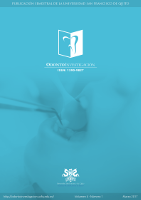Limitación de la apertura bucal por hiperplasia de apófisis coronoides: reporte de un caso.
Contenido principal del artículo
Resumen
La hiperplasia de los procesos coronoideos es una afección muy rara, caracterizada por la elongación de las coronoides en donde se produce un contacto prematuro con la superficie posterior del hueso cigomático. Esto dará como resultado la restricción mecánica de la apertura bucal. El tratamiento de elección es la coronoidectomia intraoral de forma bilateral. En este artículo reportamos el caso de un paciente de 15 años con una marcada limitación de la apertura bucal, donde se le realizó resección bilateral de los procesos coronoideos de forma intra oral.
Detalles del artículo
Citas
Miguel P, Raquel G, Gonzalo P. The hypothetical role of congenital hypotonia in the development of early coronoid hyperplasia. Journal of Cranio-Maxillo-Facial Surgery 2012; 40: 155-158.
C. H. Mulder, S. I. Kalaykova, R. A. Th. Gortzak: Coronoid process hyperplasia: a systematic review of the literature from 1995. Int. J. Oral Maxillofac. Surg. 2012; 41: 1483-1489.
Stopa Z, Wanyura H, Kowalczyk P. Coronoid-condylar index in assessing of mandibular coronoid hyperplasia. Preliminary results. Advances in Medical Sciences Vol. 2013;58(2):429-433.
Carlos A, Gabriel L. Hiperplasia de procesos coronoideos mandibulares: un nuevo tratamiento posquirúrgico. Rev Esp Cir Oral Maxilofac. 2015;3 7(2):93-98.
F. Tavassol, S. Spalthoff, H. Essig, M. Bredt, N.C. Gellrich. Elongated coronoid process: CT-based quantitative analysis of the coronoid process and review of literature. Int. J. Oral Maxillofac. Surg. 2012; 41: 331-338.
Matthias W, Matthias M, Mirjam S. Hyperplasia of the Coronoid Process. Asian J Oral Maxillofac Surg 2006;18(1):51-58.
Koji S, Shigeo O, Takako A. J Oral Maxillofac Surg 2006;64:334-338.
J. Gagea, A. Galluccia, R. Stroumsaa. Coronoïdectomie intra-orale: note technique Transoral. Rev Stomatol Chir Maxillofac Chir Orale 2015;116:368-371.
James G, Choi B, Sang Y, Antonio R. Bilateral Coronoid Process Hyperplasia With Pseudocartilaginous Joint Formation: Jacob Disease. J Oral Maxillofac Surg 2013;71:316-321.
Gerbino S, Bianchi M. Bernardi S. Hyperplasia of the mandibular coronoid process: long-term follow-up after coronoidotomy. Journal of Cranio-Maxillofacial Surgery 1997; 25, 169-173.
Mcloughlin C, Hopper, Bowley. Hyperplasia of the Mandibular Coronoid Process: An Analysis of 31 Cases and a Review of the Literature. J Oral Maxillofac Surg 1995; 53:250-255.
Masperoa C, Gianninia L, Terzib L, Sessob G. Iperplasia bilaterale del processo coronoideo in pazienti pediatrici, Bilateral hyperplasia of the coronoid process in pediatric patients. Dental CADMOS 2012;80(10):559-565.
Ashish C, Priya J. Coronoid hyperplasia in chronic progressive trismus. Medical Hypotheses 2011; 77:863-868.
G. Smyth, M. J. C. Wake. Recurrent bilateral coronoid hyperplasia: an unusual case. British Journal of Oral and Maxillofacial Surgery 1994; 32:100.104.
Gibbons A, Abulhoul S. Use of a Therabite appliance in the management of bilateral mandibular coronoid hyperplasia. British Journal of Oral and Maxillofacial Surgery 2007;45:505-506.
Annika I, Caran Z, Kyung S. Mandibular coronoid process locking: A prospective study of frequency and association with internal derangement of the temporomandibular joint. (Oral surg. oral med. oral pathol. 1987;63:275-9.
Shi C, Zhi j, Zhi G. Bilateral coronoid hyperplasia (Jacob disease on right and elongation on left): report of a case and literature review. Oral Med Oral Pathol Oral Radiol Endod 2009;107:e64-e67.

